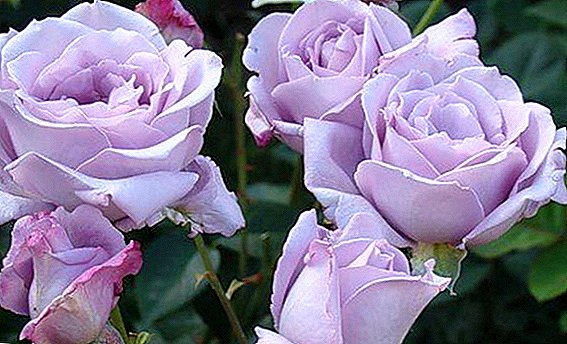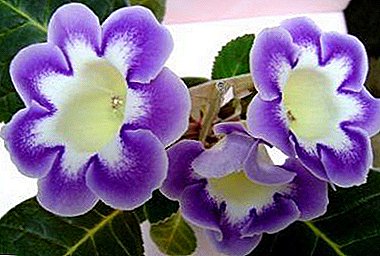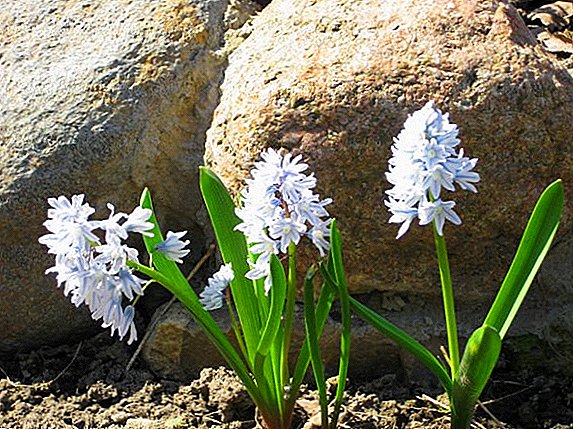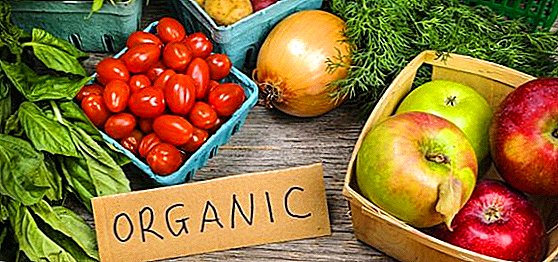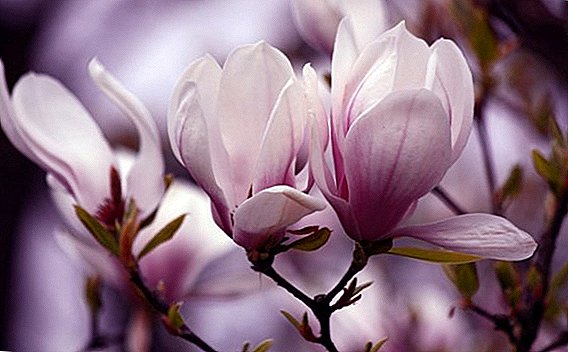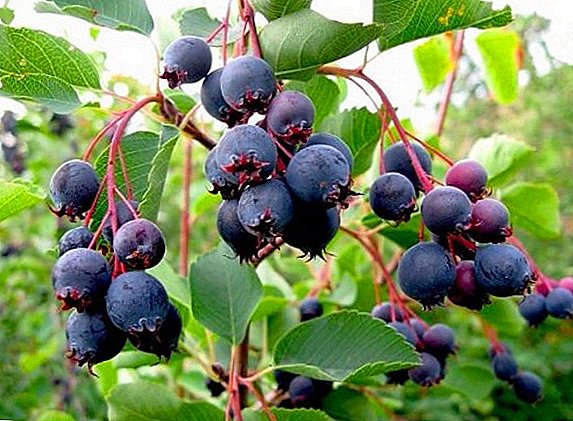 It often happens that capricious plants that require constant care and care are given increased attention, and unpretentious are treated rather carelessly. It is such a culture and is irga. Usually it can be seen somewhere on the outskirts of the backyard. But not everyone knows that irga is a unique ornamental plant, which is valued in many countries. In May, it pleases the eye with gorgeous blooms, very similar to cherry blossoms, and in September, the Irga dresses in a fancy red and yellow crown. In this article you will learn a lot of interesting things about shrub irga: planting and care, reproduction, cultivation, and other useful facts.
It often happens that capricious plants that require constant care and care are given increased attention, and unpretentious are treated rather carelessly. It is such a culture and is irga. Usually it can be seen somewhere on the outskirts of the backyard. But not everyone knows that irga is a unique ornamental plant, which is valued in many countries. In May, it pleases the eye with gorgeous blooms, very similar to cherry blossoms, and in September, the Irga dresses in a fancy red and yellow crown. In this article you will learn a lot of interesting things about shrub irga: planting and care, reproduction, cultivation, and other useful facts.
Important! Acid berries in the irgi are few, so they can safely be eaten by people with high acidity.
Irga: plant description
 Irga has many names, so its description is quite interesting. In England, this shrub is called shadbush, which means "shadow shrub"; juneberry - june berry or serviceberry - useful berry. The name currant-tree (cinnamon) was given to Irga because of its similarity with small grapes. In Russia, irgu is called a nursery or a toffee. In North America - saskatoon (saskatoon). The Provencal name of this plant is amelanche, which literally means “bring honey”.
Irga has many names, so its description is quite interesting. In England, this shrub is called shadbush, which means "shadow shrub"; juneberry - june berry or serviceberry - useful berry. The name currant-tree (cinnamon) was given to Irga because of its similarity with small grapes. In Russia, irgu is called a nursery or a toffee. In North America - saskatoon (saskatoon). The Provencal name of this plant is amelanche, which literally means “bring honey”.
Irga genus belongs to the Rosaceae family. It includes 18 species (according to some sources - 25), most of which grow in North America. Irga is often found on forest edges, sunny rocky slopes, in glades. In the open spaces of Russia, mainly round-leaved irga grows, whose homeland is considered to be the Caucasus and the Crimea. In Ukraine, about 10 species of this plant are known: the spiky irga, Canadian irga, blood red irga and others. Often they grow in the wild. Culture spreads through the birds, so irgu can often be found on the edge of the forest.
The plant is not afraid of drought and wind, it feels great on any soil, except for swampy areas, it is not afraid of severe frosts. Irriga's vitality is explained simply: the roots of the plant make their way two meters deep and diverge within a radius of two and a half meters. For this reason, irga is not afraid of shade, polluted air, it is not afraid of diseases and pests, the culture quickly grows and tolerates pruning. Among their kin, irga is a long-lived - many shrubs reach the age of 70 years or more. And most importantly, this plant is a honey plant.
 But if you want an irga to grow on the plot, not only planting and grooming is important, but also knowledge about the side effects of this plant. They are few. The spikeberry irgie has strong root growth, therefore it will have to be removed all the time. And it is also undesirable to plant irgu near the parking lot - cars of light colors may suffer from stains that will leave fallen berries.
But if you want an irga to grow on the plot, not only planting and grooming is important, but also knowledge about the side effects of this plant. They are few. The spikeberry irgie has strong root growth, therefore it will have to be removed all the time. And it is also undesirable to plant irgu near the parking lot - cars of light colors may suffer from stains that will leave fallen berries.
Did you know? The fruits of the irgi are so tasty that they have to literally “beat off” the harvest - the birds peck off ripened berries with lightning speed.
Soil preparation and site selection for shrubs
The plant is completely unpretentious to external conditions. But since irga is a fruitful berry shrub, he loves indirect sunlight. The best crop can be harvested if the irga is planted on sandy sod-podzolic and loamy fertile soils.
Irga is not afraid of the shadow and the lack of moisture, so it can safely give the territory along the fence. Irga is planted in the same way as other berry bushes, such as currants or gooseberries. Seedlings are lowered into the ground in the fall or spring 8 cm deeper than they grew before. This is done in order to grow a large number of basal shoots. The optimally convenient and beautiful option is to plant an irgu as a hedge.
How to plant irgu
 It is recommended to plant 1-3 irgi plants in the garden. Under each shrub you need to take 16m² of fertile loamy soil and 9m² of sandy loam. For seedlings prepare pits 80 cm wide and 40 cm deep. After planting, the bushes are watered, humus or peat is put on the soil surface, it is desirable to shorten the ground part of the bush to 10 cm so that 4-5 developed buds remain above the soil level. About what are the buds of irgi, which bloom in late April, will tell this photo.
It is recommended to plant 1-3 irgi plants in the garden. Under each shrub you need to take 16m² of fertile loamy soil and 9m² of sandy loam. For seedlings prepare pits 80 cm wide and 40 cm deep. After planting, the bushes are watered, humus or peat is put on the soil surface, it is desirable to shorten the ground part of the bush to 10 cm so that 4-5 developed buds remain above the soil level. About what are the buds of irgi, which bloom in late April, will tell this photo.
Did you know? Irga is so unpretentious that under any natural conditions it bears excellent fruit.
Do I need to water irgu
Shrubs irgi remarkably take root after planting and do not require special care, they grow and bear fruit. But with sufficient and regular watering the number of fruits increases markedly. Wet soil protects the roots better and allows the shrub to always be healthy and strong.
Features dressing irgi
In the summer, irgiu is fed with liquid mixtures, which consist of water and ammonium nitrate at the rate of 50 g per shrub or 5 l of a 10% solution of bird droppings. It is best to feed the plant in the evening after heavy watering or rain.
How to cut a plant
 It is best to form an irgu in the form of a multi-trunk bush from powerful basal shoots, and to remove the weak ones.
It is best to form an irgu in the form of a multi-trunk bush from powerful basal shoots, and to remove the weak ones.
The first pruning of the shrub is carried out during planting, on a young plant no more than six healthy buds are left. From them then sprouts grow. Until the age of three, all shoots must be preserved, and then no more than three of the annual increment should be left. Powerful and healthy branches be sure to save. Each year on the shrub should be about 15 branches from different growths. If their growth worsens, then once in 4 years it is worth making a rejuvenating pruning. But such a procedure can be performed only with bushes that have already reached the age of ten.
To make it convenient for you to harvest, shorten the branches to the desired height. After pruning, irga independently grows root shoots.
Features of care in the first years of life
In the first year after planting, an rye grows well, cultivation and care are carried out without any particularities. The main thing that is needed is in early spring, before the buds have swelled and dismissed, all vertically growing branches of the shrub need to be cut, reducing their height by a quarter.
Pruning and forming an adult bush
A properly formed bush of irgi produces many times more fruits than a plant that has not been pruned and shaped. If an irgu is grown as an ornamental decoration of a garden, her crown also needs a “stylish hairstyle”. Most of all, this procedure is needed mature branches. It is important to cut the plant properly so as not to do more harm than good.
 The main task is to rejuvenate irgu. There are two types of treatment: thinning and shortening. When thinning, the weak, diseased and deep-growing crowns of the branches are removed entirely. Thinning should be carried out every year. During shortening, only the tip of the shoot is removed, and several buds remain intact. Thus, it is possible to change the appearance of the crown, it becomes more dense and wide due to the young shoots.
The main task is to rejuvenate irgu. There are two types of treatment: thinning and shortening. When thinning, the weak, diseased and deep-growing crowns of the branches are removed entirely. Thinning should be carried out every year. During shortening, only the tip of the shoot is removed, and several buds remain intact. Thus, it is possible to change the appearance of the crown, it becomes more dense and wide due to the young shoots.
If you want to fill the void in the center of the crown, you need to remove the escape, leaving only the extreme kidney, which is directed inside the shrub. Later, a vertical shoot will grow from this bud. Shorten irgu several times: during the first treatment, during the procedure of forming a young crown, as well as when the plant goes up strongly and the harvest is not hand.
Important! Berry fruit contains B vitamins, ascorbic acid, anthocyanins, pectin and beta-sitosterol, which is an effective cholesterol antagonist.Branches older than six years are removed without regret. They will quickly be replaced by powerful basal shoots. For irgi grown for decorative purposes, the crown is formed on the basis of the task. For example, if a hedge is wanted from a plant, branches are shortened in height and width.
Pruning shrub irga produced in the spring before the swelling of the kidneys or fall, when the leaves fall.
How to propagate irgu correctly
There are several ways of breeding shadberry:
- seeds;
- grafting;
- slips;
- division of the bush.

Cuttings
Experienced gardeners like to grow irga by cutting, as this requires certain knowledge and experience. Cuttings from last year's growth are cut in the fall, and then stored for planting until spring, dug in sand or earth. For rootstock use two-year rowan. When spring awakening comes, the cuttings are dug, the roots are washed and the trunks are incised: above the kidney and under it. The lower end of the seedling shadberry is sharp and inserted into the slit stock. This place is tightly wrapped with plastic wrap. After grafting, plants are placed in a greenhouse until they grow together. Irgi shrubs can serve as a stock for apples and pears. This plant transmits early flowering and frost resistance to fruit trees.
Grafting plants
 In June or July, cuttings are cut from the tops of the shoots of five-year-old shrubs. In length, they should be no more than 15 cm. From each stalk, remove the lower leaves, leaving some upper ones. Billets with lower sections are placed for 12 hours in a root-forming agent, and then the roots are washed in pure water. After that, you can plant irgu in clean soil in a cool greenhouse. They do it at an inclination and at a distance of 4 cm. From above the soil is covered with a layer of sand 10 cm thick. Ideally, the cuttings should be 20 cm below the ceiling of the greenhouse.
In June or July, cuttings are cut from the tops of the shoots of five-year-old shrubs. In length, they should be no more than 15 cm. From each stalk, remove the lower leaves, leaving some upper ones. Billets with lower sections are placed for 12 hours in a root-forming agent, and then the roots are washed in pure water. After that, you can plant irgu in clean soil in a cool greenhouse. They do it at an inclination and at a distance of 4 cm. From above the soil is covered with a layer of sand 10 cm thick. Ideally, the cuttings should be 20 cm below the ceiling of the greenhouse.
Planting cuttings, pour them so that the water is sprayed. The temperature inside the greenhouse should not exceed 25 ° C. To do this, it is necessary from time to time to remove the top of the greenhouse and air cuttings. Watch the soil - it should be wet. After the cuttings take root, you need to remove the dome of the greenhouse during the day, and after they get stronger, you should not put on the dome even at night.
After three weeks, the cuttings will develop a strong root system, and they will be ready for transplanting to a temporary bed. Here they need to be fertilized with manure diluted with water in a ratio of 1: 8, or ammonium nitrate dissolved in water in a bucket. Caring for cuttings is no different from caring for an adult shrub, and next fall they are transplanted to a permanent habitat.
Reproduction by layering
For this method of reproduction suitable one-year strong shoots or biennial branches with powerful growths. Drop them in the spring, as soon as the sun warms up the soil a little. The top layer under the bushes, which will be taken bends, you need to dig, pour fertilizer and level. After this, create soil and fasten shoots that grow low in the furrows. Tops need to pinch. When the buds grow shoots 12 cm in height, they must be half covered with humus. When the shoots grow another 15 cm, the procedure should be repeated. Layers that have taken root are planted next fall to a permanent place. 
Growing shadberry seeds
This is the best, but at the same time the longest way to grow irgi. Seeds can be bought or independently collected from ripe fruits. They are not dried, not mixed with sand and stored in a cold place (basement, refrigerator) before sowing.. If the seeds are pre-prepared, they will grow better. Put them between cotton wool soaked in hydrogen peroxide and wrap everything in plastic wrap. Keep it in this condition for 4 months.
In spring, the seeds are planted in a small greenhouse at a distance of 20 cm from each other. Shoots will be visible in two or three weeks. You can sow the seeds in specially prepared beds in the fall. This will be growing irgi in the open field. Seeds will grow in the spring.


